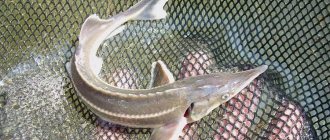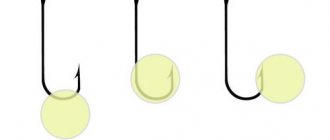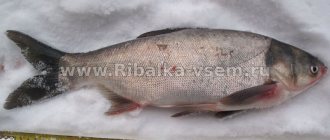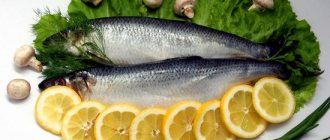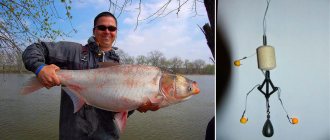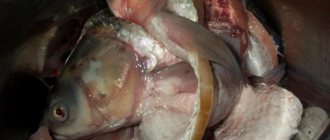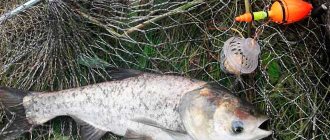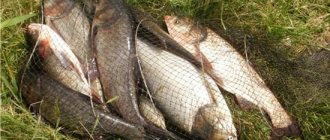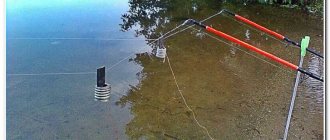Catching silver carp is quite an interesting activity, since until recently no one used a fishing rod for this purpose. It was a coveted and elusive trophy for many fishermen, since its diet differs from that of ordinary fish, this breed is completely indifferent to standard baits and complementary foods.
None of the experiments that consisted of attempts to attract his interest in this or that food were successful. The situation changed dramatically with the advent of a fundamentally new bait - technoplankton.
Silver carp fishing tackle and rigging
Initially, you need to prepare all the necessary equipment.
You can catch silver carp using a regular float rod or bottom tackle; the nuances of their configuration have no fundamental differences and are as follows:
- The rod must have sufficient power and be durable , since this fish is very strong. If you want to catch the largest and most trophy specimens, you must take into account that their body weight can reach 30 kg, so the tackle must withstand such prey. The length of the rod is selected individually in each case and depends on the characteristics of fishing; usually this figure is within 2.7-3.5 meters.
- The reel should also be powerful enough , the recommended size is 4000-4500, and the spool capacity should be at least 100-150 meters with a working line diameter of about 0.3 mm. This device must be equipped with a friction brake and a baitrunner.
- The sinker can be stationary or sliding type ; it must be attached to the working line or to the equipment itself. Weight is determined in each situation separately, since this parameter depends on the depth of the place chosen for fishing, but usually it ranges from 30 to 100 grams.
- The size of the hooks depends on the expected size of the potential prey; traditionally, No. 6, No. 7 or No. 8 are used.
- The float must be made of polystyrene foam ; it is good if it is additionally equipped with a feeder tube, which is an anti-twist.
- Tremple is a special device that must be available when fishing for silver carp. It is a triangular-shaped structure, which is made of durable metal wire or a special type of plastic. The trample has a special pin on which technoplankton is attached, which is the only effective bait. The design includes special ears; they are designed for fastening and fixing the working line or used leashes.
What to use to catch silver carp from the bottom
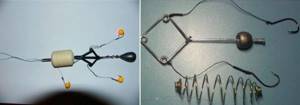
Today, there are two effective ways to “hunt” silver carp if it is closer to the bottom. To understand the whole principle of catching it, you should dwell on what silver carp feeds in nature. This fish feeds on tiny particles called plankton. The particles are so small that they resemble a cloud of turbidity. Based on this feature, one should focus on the formation of a cloud of nutrient medium in which hooks float freely. Both methods are similar to each other, since the first method involves the use of purchased phytoplankton, and the second method is designed for the use of special home-made porridges. This can be porridge with the addition of purchased bait such as “Geyser”.
Before technoplankton appeared, anglers tried to catch silver carp using various baits of plant origin, including corn or peas. There have been cases of catching on unconventional types of baits. But this is purely an accident and in no way a pattern. Most likely, in such cases, an accidental hit of the hook with a nozzle occurred during the process of the fish sucking in the nutrient medium. Over time, this fish began to get used to the baits offered to it by fishermen, and with the advent of technoplankton on sale, the fishing process changed dramatically.
When fishing for silver carp, you should always remember that the constantly created cloud of turbidity in the area where the hooks are located is the basis for effective fishing. In this case, the hooks should be located not too far from the bottom and should be well camouflaged by this cloud. To ensure that the hooks are not at the bottom, but in the water column, foam balls should be placed on them. The balls are placed in such a way that the sting necessarily peeks out of the foam, otherwise idle bites are possible.
Considering the fact that silver carp has a large mouth, it is better to choose large hooks. Hooks from No. 1 to No. 3 are perfect. They must be both sharp and strong, since the silver carp’s mouth is quite powerful. At the same time, you should constantly monitor their sharpness, otherwise there may be idle bites and fish disappearances.
Bait for fishing
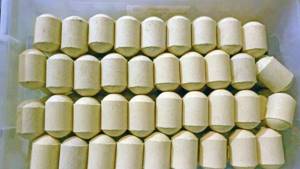
Technoplankton will serve not only as bait, but also as complementary food, attracting prey from great distances to the fishing site.
You need to know the following features associated with this atypical type of bait:
- Technoplankton is most often sold in the form of compressed tablets , which are used in conjunction with tremple. However, there is also an uncompressed version of this bait; it is usually poured into special feeders, which are then lowered into the water. This type is usually not store-bought, but home-made varieties.
- The compressed tablets contain various substances that remind the silver carp of the food included in its usual diet. Additional ingredients are special components that increase the fish’s appetite, that is, they are actually bite activators. Also, most options contain aromatic additives, for example, based on raspberries, vanillin, honey, anise or baits of animal origin; they are necessary to attract the attention of prey to the place where it is caught.
- Making technoplankton at home is gradually beginning to gain popularity , but it must be borne in mind that it is not as universal a remedy as store-bought baits. Most often, the use of a homemade product gives a positive result only in well-studied reservoirs, where it has already been repeatedly tested in practice; in other cases, there is a certain risk of returning home without a catch.
- After compressed or crumbly technoplankton enters the water , it begins to gradually become wet. As a result, a specific food cloud is formed in the depths of the reservoir, and a spot appears on the surface of the water, which emits an aroma that attracts silver carp.
Technoplankton Recipes
For fishermen who want to experiment with homemade baits, below is one recipe for making technoplankton yourself at home:
- in equal quantities ; the recommended volume is half a kilogram of each ingredient.
- About 300 g is poured into the mixture. breadcrumbs and the same amount of steeply brewed porridge, which is prepared on the basis of corn flour.
- 300 g is added as an additional sweetener and flavoring vanilla sugar.
- All components must be thoroughly mixed to obtain a homogeneous mass.
- To give the mixture the necessary structure , it will need to be soaked with a small amount of water, to which you can first add honey, it will increase the catchability of the resulting bait.
There is also an alternative recipe for preparing technoplankton, the main component of which is condensed milk.
To obtain such bait, you must use the following algorithm of actions:
- into a separate container at once.
- Mix the condensed milk with a mixer , which is set to medium-speed revolutions; at the same time, dry powder-type cake and powdered milk are added to it. The amount of ingredients used must be equal.
- The resulting mass must be mixed until its structure begins to resemble fairly thick sour cream.
- Without removing the mass from the container in which it was prepared, you need to place it in the freezer and keep it there for about 30 minutes.
- After the specified period, the mixture is taken out of the refrigerator and kneaded by hand until the structure resembles dough. If the bait does not acquire the required shape, then in parallel you can add small quantities of dry ingredients that have already been used previously.
- The last component is added to the dough-like mass - half a kilogram of breadcrumbs, after which the mixture is thoroughly mixed again.
- Further actions depend on how you plan to use this bait. Technoplankton can be compressed or left in its original form, then it will sink into the reservoir while in the feeder.
https://www.youtube.com/watch?v=bwwxdzWteSw
Bait for silver carp
You can feed silver carp using both purchased and homemade baits. The undoubted advantage of self-made ones is that you can adjust the composition depending on the fishing conditions. There are many bait recipes.
Pea bait. To prepare it we will need:
- 1 kg of pea porridge.
- 1 kg semolina.
- 100 grams of milk powder.
Cook the peas until they form a puree-like consistency. Remove the porridge from the stove and add dry milk and semolina. Cool the porridge and knead it until a thick mass is formed. The end result should be a dough-like mass. If there is no semolina, then you can use bran or flour.
Another fairly common recipe is the following, for which you will not need:
- Corn flour – 1 kg.
- Wheat flour – 1 kg.
- Rice flour – 200 grams.
- Powdered milk – 100 grams;
Mix everything except milk powder and pour in sweet syrup. To prepare this syrup, use sugar (200 grams) and water (200 grams). After the syrup has been added, we leave the resulting mass to soak for several hours. After two hours, pour everything into cellophane and roll it up.
This bait needs to be prepared several hours before fishing.
Place and time of fishing
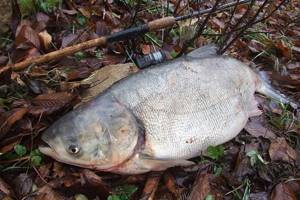
When all the gear is ready for fishing, and the technoplankton has been purchased or prepared, you can begin a new stage - finding a place to catch silver carp.
This type of fish prefers to stay near the following places:
- Areas of a body of water whose bottom has a rocky or sandy structure. If there are no such places, then you can look for prey in places with a clay bottom surface.
- The optimal depth at which you need to look for silver carp is 2-3 meters, in some cases you can go down to 4 meters. Sometimes this fish is located even deeper, but this happens extremely rarely, so it is not recommended to deviate from the indicated indicators.
- The wind is another guideline for choosing a fishing spot; it’s good if it’s headwind. And when it blows towards small bays, you can be sure that this is an ideal place to find silver carp.
- Places with sharp changes in depth levels , especially in small reservoirs with a rocky shore, are also ideal for fishing, since in them you can find not just single individuals, but whole schools of fish.
- Places with a lot of vegetation , contrary to what many people think, are not a good solution for finding silver carp, since fresh greenery, algae and dense thickets do not attract it, unlike many other fish species.
If we talk about the time of day that is most suitable for fishing, then most often weather conditions have a much greater influence on the bite. Silver carp becomes significantly more passive in the absence of wind, high atmospheric pressure, severe cloudiness or changes in temperature.
During the occurrence of such unfavorable conditions for it, the chances of a daytime bite are virtually completely absent; in the evening the fish becomes more active, but even at these hours it is quite difficult to assess the chances of success.
She begins to be more active closer to midnight, when her appetite awakens. Silver carp continues to feed until the early morning, and then loses activity again, so night fishing is considered the most productive.
Where does this fish live at different times of the year?
This fish can be caught all year round, and experienced fishermen say that the number of silver carp caught depends on knowledge of their habitats and climatic conditions. These river inhabitants feed on plant plankton, simultaneously cleaning the river bottom and making the water much cleaner.
Usually this fish is found in reservoirs with a sandy or clay bottom.
From the beginning of spring to the end of summer, silver carp begin to actively feed after a winter dormant period. They actively search for food, being almost at the surface of the water. therefore, with properly selected feeding and bait, even a novice angler will not leave without this fish.
The “menu” of silver carp includes small fish, silt, algae, plankton, remains of rotting plants, and other vegetation.
However, you can catch this fish even in winter if you know its habitats and prepare the appropriate types of bait and bait. It should be taken into account that they will have to be lowered to the bottom of the reservoir, where the silver carp are located at this time.
In winter, you can count on catching this fish when the first ice sets in, as well as during the period when the ice melts. Although at this time the fish are usually passive, they still come out of the wintering pits to feed.
When there is a thaw and there is little food in the river or lake, silver carp are caught using bait prepared for other types of fish.
Read: Bream fishing in February
In the autumn, it is better to go out for silver carp in quiet and warm times, choosing shallow reservoirs in which there is practically no current or it is weak. In such conditions it is easier to catch even large specimens.
When the temperature of reservoirs and the environment decreases, these fish go deeper and bites are much less frequent. And with the beginning of spring, silver carp becomes active, especially before the start of spawning - the fish seems to store food for future use and rushes to almost any bait.
Fishing technique
The last thing that fishermen who go after silver carp absolutely need to know is the specifics of the technique and tactics of catching it; there is nothing complicated about them.
The main requirements and recommendations regarding this process that can help increase catch are given below:
- Pre-prepared equipment is pointedly thrown into the fishing area.
- After a perfect cast , it is recommended to place the rod on a special stand, and not hold it in your hands, this minimizes the risk that the silver carp may notice the fisherman.
- When using a regular fishing rod, the bite is controlled in the traditional way by the reaction of the float. If bottom tackle was used, then this process is carried out by observing the end of the rod, but for convenience it is recommended to equip the bottom with a bell or an electronic alarm so that information about the bite can be obtained using sound.
- The first bite can begin no earlier than 1.5-2 hours after casting the bait , since technoplankton needs time to spread in the water. As soon as the silver carp smells it, it will immediately swim to the required place and begin to suck in food, while it must swallow one of the hooks. As soon as this happens, it is necessary to immediately hook the prey.
- There is no need to rush into fishing ; it is better to take the prey to a cleaner area of the reservoir so that it does not scare away its relatives. As soon as the silver carp is tired enough and stops resisting, you can begin to pull it ashore.
Blitz tips
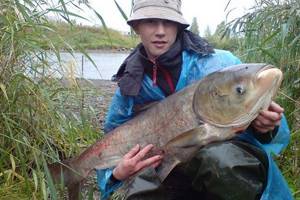
- If you plan to catch the largest or trophy specimens , then you will need to take a hook with you, since such individuals are unlikely to fit into the landing net.
- When making technoplankton at home, you can experiment with the composition, but it is not recommended to include more than 3-4 different components in the bait, since this is unlikely to attract prey.
- The hook and leashes used must be thin , since silver carp can notice these devices, which will reduce the likelihood of a bite to zero. At the same time, they must be of sufficient strength, taking into account the strength of the fish being caught.
- Every 30 minutes you need to change the bait in the trap. You can carry out this procedure more often, but not less often, otherwise the biting will gradually stop.
- The presence of calm is a negative factor ; in such cases, the likelihood of a bite, especially in the daytime, is minimal.
- Casts should be made to the same place, and the bait should not be pulled up. The food cloud created by technoplankton should remain strictly above the bait, which makes it less noticeable and increases the chance that the silver carp will accidentally swallow it while feeding.
